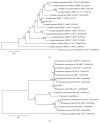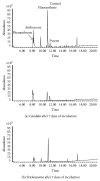Isolation and Characterization of Hydrocarbon-Degrading Yeast Strains from Petroleum Contaminated Industrial Wastewater
- PMID: 26339653
- PMCID: PMC4538589
- DOI: 10.1155/2015/929424
Isolation and Characterization of Hydrocarbon-Degrading Yeast Strains from Petroleum Contaminated Industrial Wastewater
Abstract
Two yeast strains are enriched and isolated from industrial refinery wastewater. These strains were observed for their ability to utilize several classes of petroleum hydrocarbons substrates, such as n-alkanes and aromatic hydrocarbons as a sole carbon source. Phylogenetic analysis based on the D1/D2 variable domain and the ITS-region sequences indicated that strains HC1 and HC4 were members of the genera Candida and Trichosporon, respectively. The mechanism of hydrocarbon uptaking by yeast, Candida, and Trichosporon has been studied by means of the kinetic analysis of hydrocarbons-degrading yeasts growth and substrate assimilation. Biodegradation capacity and biomass quantity were daily measured during twelve days by gravimetric analysis and gas chromatography coupled with mass spectrometry techniques. Removal of n-alkanes indicated a strong ability of hydrocarbon biodegradation by the isolated yeast strains. These two strains grew on long-chain n-alkane, diesel oil, and crude oil but failed to grow on short-chain n-alkane and aromatic hydrocarbons. Growth measurement attributes of the isolates, using n-hexadecane, diesel oil, and crude oil as substrates, showed that strain HC1 had better degradation for hydrocarbon substrates than strain HC4. In conclusion, these yeast strains can be useful for the bioremediation process and decreasing petroleum pollution in wastewater contaminated with petroleum hydrocarbons.
Figures







References
-
- Maila M. P., Cloete T. E. The use of biological activities to monitor the removal of fuel contaminants—perspective for monitoring hydrocarbon contamination: a review. International Biodeterioration and Biodegradation. 2005;55(1):1–8. doi: 10.1016/j.ibiod.2004.10.003. - DOI
-
- Berry C. J., Story S., Altman D. J., et al. Biological treatment of petroleum in radiologically contaminated soil. In: Clark C. J. II, Stephenson Lindner A., editors. Remediation of Hazardous Waste in the Subsurface. Bridging Flask and Field. American Chemical Society; 2006. pp. 87–103.
-
- Tanase A.-M., Ionescu R., Chiciudean I., Vassu T., Stoica I. Characterization of hydrocarbon-degrading bacterial strains isolated from oil-polluted soil. International Biodeterioration & Biodegradation. 2013;84:150–154. doi: 10.1016/j.ibiod.2012.05.022. - DOI
-
- Okerentugba P. O., Ezeronye O. U. Petroleum degrading potentials of single and mixed microbial cultures isolated from rivers and refinery effluent in Nigeria. African Journal of Biotechnology. 2003;2(9):312–319. doi: 10.5897/AJB2003.000-1064. - DOI
MeSH terms
Substances
LinkOut - more resources
Full Text Sources
Other Literature Sources
Molecular Biology Databases

